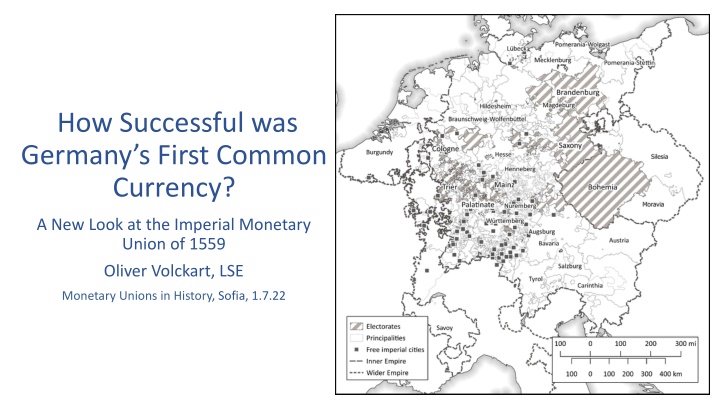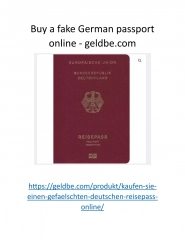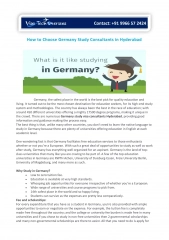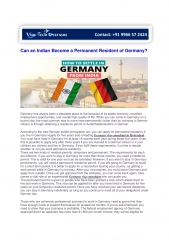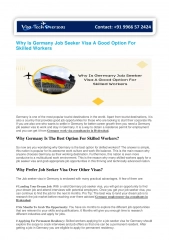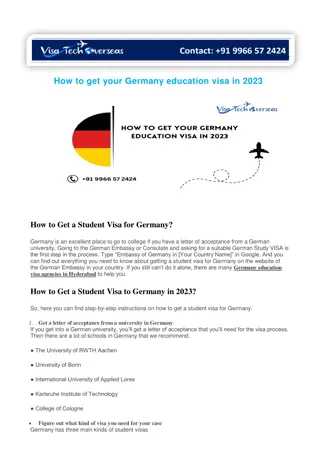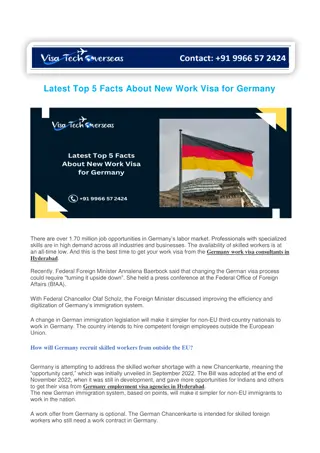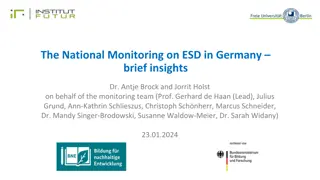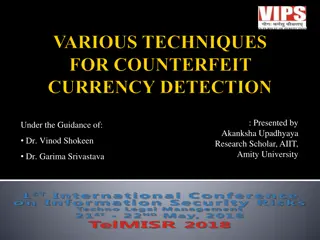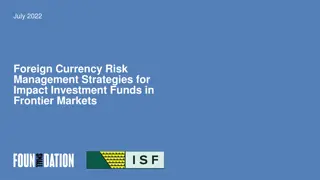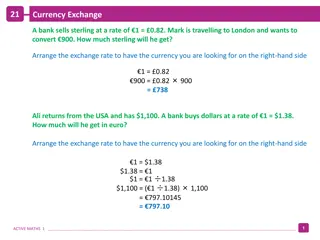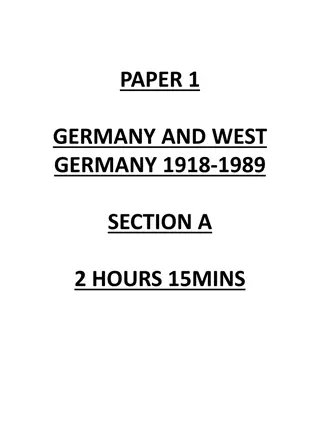Germany's First Common Currency: A Historical Analysis
Germany's first common currency in 1559 is examined in this research, scrutinizing its success, impact on monetary stability, and comparison to other currencies of the time. Economic and monetary historians present varying perspectives on the effectiveness of the Imperial Monetary Union. Factors influencing monetary policies and the currency's intended goals are explored to gauge its achievements.
Download Presentation

Please find below an Image/Link to download the presentation.
The content on the website is provided AS IS for your information and personal use only. It may not be sold, licensed, or shared on other websites without obtaining consent from the author.If you encounter any issues during the download, it is possible that the publisher has removed the file from their server.
You are allowed to download the files provided on this website for personal or commercial use, subject to the condition that they are used lawfully. All files are the property of their respective owners.
The content on the website is provided AS IS for your information and personal use only. It may not be sold, licensed, or shared on other websites without obtaining consent from the author.
E N D
Presentation Transcript
How Successful was Germany s First Common Currency? A New Look at the Imperial Monetary Union of 1559 Oliver Volckart, LSE Monetary Unions in History, Sofia, 1.7.22 1
Research survey, hypotheses (1) Economic historians: Moderately successful Failure L tge 1966, Henning 1991: Mathis 1992: Monetary historians: Inconclusive, transient success, no breakthrough, no more than an attempt Blaich 1971, Rittmann 1975, Gerhard 1994, Sprenger 2002, R ssner 2014: Generally: Since 1970s re-assessment of the historical role of the HRE. Current orthodoxy: The Empire was a state roughly as effective as others at the time. 2
Research survey, hypotheses (2) Two criteria to assess success or failure: 1. Did the common currency achieve what it was designed to achieve? 2. How similar was it to other currencies of the time? My hypotheses: Ad 1: The common currency was moderately successful in preventing Gresham s Law from undermining monetary stability. Ad 2: It did not differ much from other currencies. 3
Structure 1. Which conditions shaped monetary policies at the level of the Empire? 2. What was the common currency intended to achieve? 3. Did the common currency achieve its aims? 4. Conclusion 4
Which conditions shaped monetary policies at the level of the Empire? (1) 1. C. 1550 ~ 100 authorities that issue coin (commodity money only) 2. No currency borders within the Empire or between it and its neighbours 3. State capacities insufficient for withdrawing old money from circulation when new money is issued 4. Goods-, currency- and capital-markets quickly integrate over the 15th and 16th centuries 5
Which conditions shaped monetary policies at the level of the Empire? (2) 0.70 0.65 0.60 0.55 0.50 0.45 0.40 0.35 0.30 0.25 1490 1500 1510 1520 1530 1540 1550 1560 1570 1580 1590 1600 1610 1620 Goods market integration in Europe (balanced sample, 31 markets) CV of wheat prices, 1495-1618 (Chilosi & Volckart 2011: 769) (Own dataset) 6
1551 Augsburg coinage Ordinance introduces common bimetallic currency 1559 Amendment abandons bimetallism 1566 Amendment adopts the Taler. The common-currency zone 1571 7
What was the common currency intended to achieve? (1) Prior research: Economic integration (Blaich 1970; Probszt 1973; Sch n 2008; Boerner and Volckart 2011; R ssner 2014; K mper 2020). But: 1. No evidence for imperial estates considering the interests of commerce when making monetary policy-decisions at the level of the Empire 2. Long-distance trade copes with monetary diversity: Use of international money (e.g. Rhine florin, Taler) Use of cashless means of payment (Bills of exchange, negotiable and transferrable from c. 1530) 8
What was the common currency intended to achieve? (2) Remember: Increasing integration, lack of currency borders. Bohemian royal council, memo to King Ferdinand (June 1543). The counsellors claim that everyone knew his royal Majesty s silver-rich coin had not benefited his Majesty s land and people, but that the money had all been exported like a commercial good, melted elsewhere and re-minted into poorer coins which, together with other light coins, had then been re-imported into the country and become common (Eltz 2001, no. 70, p. 341). Trade in coinage; breaking money; Gresham s Law 9
What was the common currency intended to achieve? (3) Gov. of Lower Austria, Report to King Ferdinand (Feb. 1553). Most gracious lord, we are herewith sending your Roman Royal Majesty copies of two letters together with a purse of coins from Henneberg, which we have received from your Royal Majesty s councillor and governor of Carinthia, Christoph Khevenh ller, and said two letters describe how this coinage from Henneberg has flooded Carinthia and is increasing to such an extent that the common man cannot obtain any other money whatsoever, which is a great hardship for the country folk (HHStA, RHR, Miscellanea M nzwesen 2: M nzwesen im Reich, 1551-1564, fol. 443r.). Increasing market integration: Small change travels long distances. 10
What was the common currency intended to achieve? (4) Andreas Funcke, electoral-Saxon MM, to the elector, 1521: If this unworthy coin [small change from Brandenburg] is being accepted in your princely grace s lands, your people will suffer palpable harm, and things will become as bad as they were when Brandenburg Groschens and other poor coins were circulating . Also, the Gulden is again gone up, and this unworthy coin will drive it up further to 21 Groschens. If that comes to pass, the good coins will all be exported, and these bad ones alone will stay in the land. Already now all purses are full of bad Pfennigs, as your princely grace will discover in your revenues from convoy services, taxes and rents (Bahrfeldt 1895, no. 14, p. 411). revenue effects 11
What was the common currency intended to achieve? (5) Solution 1: Defensive debasements race to the bottom, monetary instability Solution 2: Closing the mint, harmonisation Thomas Kantzow, Pomeranian Chronicler (c. 1540): The dukes of Pomerania put down the hammer, trusting that one day his imperial Majesty would mandate a common coinage for all German lands (B hmer 1835, p. 164). The elector-Palatine at a monetary policy-conference (July 1557): One thing is certain: When all estates mint according to the same standard that they faithfully observe, the breaking of coins is impossible because it can no longer be done without incurring a loss (Volckart 2017, no. 100, p. 405). 12
Did the common currency achieve its aim? (1) Two interlinked problems: 1. Commodity money: Producers face incentives to commit fraud. 2. Common currency = common good incentives to freeride. Solutions: Ad 1: Outsourcing of mints prohibited Ad 1: Estates required to appoint assayers Ad 2: Imperial circles required to organise twice-yearly circle-level assays ( probation diets ; non-minting estates allowed to take part incentives to report rule violations) Ad 2: Number of mints per circle restricted to four fewer chances to break money. 13
Did the common currency achieve its aim? (2) Prior research: a) In general: Laws that are not being enforced a structural characteristic of premodern statehood (Germany: Schlumbohm 1997; France: Muchembled 1992; England: Hoppit 1997) b) In particular: The imperial circles fail (R ssner 2014). Imperial diet of Speyer 1570, recess: It is now evident what great and never-ending damage everyone of high and low status suffers solely because said currency ordinance [of 1559/66] has not been implemented by all circles and especially because one can obtain if nothing is done only poor, foreign and debased coin instead of the good, tested imperial coinage (Lanzinner 1988, no. 567, p. 1234). 14
Did the common currency achieve its aim? (3) Problem: No quantitative evidence for volume or value of trade in coinage Qualitative evidence: Upper-Saxon probation diet 1571, minutes: A mint master expelled from the Lower-Saxon circle is operating an illicit mint on behalf of counts Volrath and Charles of Mansfeld, where good coins are being melted and turned into bad and poor ones, so that at that place the Imperial Currency Ordinance is being violated in many ways. [The members of the diet] therefore request of his electoral grace [of Saxony] that his electoral grace will intervene in this and possible future other cases like it and make sure that imperial law is being enforced (Hirsch 1756, no. XLVIII, p. 119). Saxon officials destroy illicit mint, arrest personnel No. of Upper-Saxon mints reduced to four (none controlled by Mansfeld) 15
Conclusion Common currency largely stable 1559 to c. 1610-20 Reduction of number of mints reduces scope for trade in coinage Twice-yearly assays effectively detect free-riders Free-riders are being sanctioned However: 1. Inflow of foreign coinage continues (but territorial currency monopolies are nowhere established before the 19th century). 2. Small change is linked only weakly to the top-units (again a common phenomenon) Upshot: The common currency works reasonably well by the standards of the time. 16
